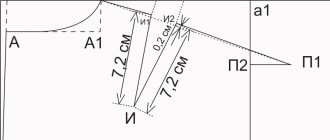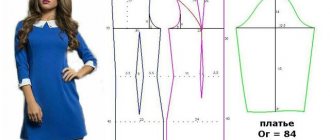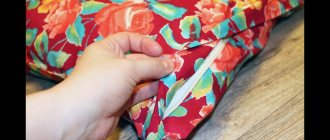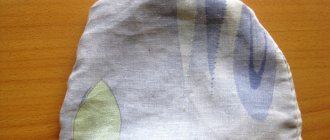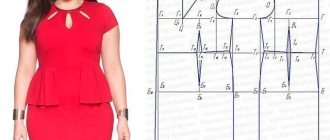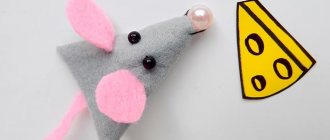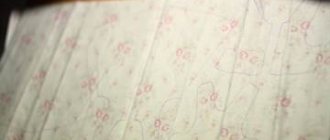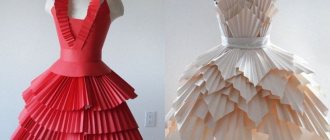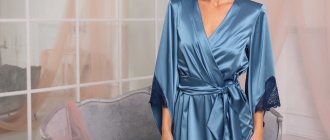How to sew a robe with your own hands without a wrap pattern?
- It is very convenient to wear a wraparound robe, since you do not need to additionally sew on buttons or zippers. In addition, fittings can break and come off, which will lead to constant repairs. This may cause you significant discomfort.
- The best material for a wraparound robe is knitwear. If you use chintz, it will fill you up. This option is only suitable for petite women.
Optimal amount of material
- If you are going to sew a wraparound robe with a width of about 150 cm, then its length should be equal to the width. If the width of the robe is about 90 cm, then it is better to double the length.
- A wraparound robe can be sewn in a universal size (from 42 to 46). If you wear size 50-54, you will need to slightly increase the width of the product.
How to cut a robe correctly?
- If you choose a narrow fabric, then you need to fold it in half in cross section. The wrong side should be inside. If you intend to use wide fabric, then it should be folded in half lengthwise. The wrong side should be inside.
- The number of seams also depends on the size of the fabric. When using wide fabric, you can make a minimum number of seams - only on the shoulder part. Narrow fabric means a straight seam on the back. To do this, you should step back about 2 cm from the left edge of the fabric and draw a future seam line.
Approximate cutting diagram
Neck line
- From the back (on the left side) from the top you need to retreat 1.5 cm to make a seam. Then you need to measure another 2 cm and mark the depth of the neck.
- From top left to right you need to mark 10 cm. This will be the width of the neck. The marked points must be connected to each other.
Product width
- It is important to quickly sew a robe with your own hands, you need to correctly determine the width of the product so that it does not hinder movement.
- In addition, wide products retain heat better, so this is an ideal option for the cold season. To determine the width of the robe, you should measure the volume of your hips, divide the value by 2, and add 20 cm to the resulting figure. That is, if the volume of your hips is 100, then the width of the robe should be 70: (100/2+20).
- Measure the width of the product from left to right. If you plan to sew large sizes (48-54), then it is better to make a small reserve.
Cut-out lines on shelves
- On the right side, from top to bottom, you need to set aside 1.5 cm to form a seam. Measure the length from shoulder to waist. From left to right (from the top) you need to measure the width of the neckline.
- The points that were obtained during the measurement process must be connected with a smooth line. To make this process easier, use a template.
How to calculate the armhole and hem line?
- Determine the center of the fabric, and measure the width of the armhole from top to bottom. To do this, you need to allocate about 2 cm per seam, and add 24 cm to the value. Cut the material along the marked line.
- If you initially correctly determined the length of the robe, then you will not need to determine the hem line. If using a large roll of fabric, measure the optimal length that will suit your height. Draw a straight line and cut out the product along the marked lines.
- a belt from leftover fabric . It is better if it is 2-5 cm wide. Such belts are more practical and durable.
Next, you need to sew up the shoulder seams and you can try on the product. You can decorate the edges of the robe with either bias tape or ruffles.
Decoration
The finished result
Can be decorated with ruffles
Oval based robe
This robe model is very simple, but when sewn with beautiful fabric, it can turn into an elegant dress.
To make it you will need any fabric you like, measuring 145 by 135 centimeters.
The fabric is cut without any pattern. Having cut an oval blank from the canvas, mark the armhole lines on it, the upper limit of which will be equal to 20 centimeters, and the length will correspond to the size of the width of the back.
Having finished cutting, the edges of the product are processed using bias tape or suitable braid. A simple robe dress is ready. You can read more about it here, and also watch cutting and sewing in the video:
So, quickly and easily, without much effort, and saving precious time, you can please yourself with a beautiful new thing by making an excellent thing with your own hands.
How to sew a wrap robe: pattern
- Before you start cutting, decide on the fabric. For the warm season, it is better to use smooth and lightweight materials that will not stick to the body. It is best to use silk.
- If you have never encountered sewing a robe, and this is the first time you are testing your strength, then it is better to refuse silk. Only experienced seamstresses can work with it. Opt for cotton, which is quite easy to use.
- For the cold season, give preference to warm materials. Remember that it is difficult to sew such fabrics by hand. To work you will need a sewing machine.
Pattern for a wraparound robe
Step-by-step instructions for the pattern:
- First you need to cut out the back. Place point A on the fabric, which will be the first vertex. Then measure the volume of your hips, add 6 cm to this value, and divide the resulting value in half.
- Measure this value from point A (to the side), and mark it with point B. Down from the first vertex you need to measure the same line, put points C and D. You should have a completed rectangle.
- Draw 4 cm down from point B and make a shoulder line. Mark the NK line. The back pattern will be done through the ABCDK points.
- Next is the sleeve pattern . From point B you need to draw a horizontal line, which should be equal to the length of AB, or part of it. It all depends on your preferences. From point D, draw a line equal to half the length AB. Call this point Y. Complete the rectangle by marking point O. Extend the shoulder line until the segment intersects with point DU. Place point G.
- Front pattern. From point A, draw a line equal to the length of the ID. Place point P. Draw a horizontal line to the left equal to the length of AB. Place point G. Step back 8 cm from segment AB and mark point M. Make a line for the front rollout of a pattern type. Connect points M and P. Move 4 cm away from it. The careless shelf is ready.
- Collar pattern. Measure the length of segments IV and SI. Combine the values to get the total. Measure the resulting length horizontally, and place points A and B. Draw the following lines: AB - 15 cm, BG - 20 cm, DG - 9 cm.
Data required for taking measurements
How to transfer measurements to material?
Step-by-step instructions to transfer measurements to fabric:
- Fold the fabric in half and make a fold that will be the center back.
- From the fold you need to set aside half the length of the maximum segment, and make allowances of 7-8 cm. Draw a line parallel to the fold to form the center of the shelf.
- At the top draw a shoulder line. Make cutouts for the neckline. Its optimal depth is 5 cm and width is 8 cm.
- From the formed neckline, make a shoulder of 10 cm and a bevel of 2 cm.
- Draw a line from the back to the waist.
- It is better to make the waist line 10 cm larger and divide the drawing width in half.
How to enlarge a pattern?
If you need to make a larger wraparound robe pattern, follow these recommendations:
- Make horizontal lines at the front, back and along the sleeve. In the chest area you need to make vertical lines.
- Cut the material along the marked lines.
- Add 10 mm to each part, and the side elements should be increased by 5 mm.
- Trace the new lines and trim them.
If necessary, you can make the pattern even larger. It all depends on your clothing size.
Correct tailoring of a robe
Step-by-step instructions for sewing a robe:
- Form the snare along the contours of the pattern, along the center of the thigh, and along the contours of the entrance to the pocket. In the central part of the back you need to make cushioning snares.
- Baste the top and bottom front pieces along the outline of the pocket entrance. Using the outer parts, sew the side and central part of the front of the robe so that the points are at the same level.
- Sew shoulder and waist darts on the back.
- Sew the different sections of the collar.
- Sew the side sections.
- Hem the hem after fitting.
- Sew on the pocket. The upper and lower parts need to be marked along the contour of the entry into the pocket. To finish the bottom edge, place the outer sides of the facing against each other. Sew the edges and make a 1cm seam.
- Move the facing to the inside , make a border seam at the bottom, and iron the area. Place a separate line 2 cm from the fold of the element. Sew the upper and lower sides of the robe in the area where it enters the pocket.
- Align the middle part of the drawing with the side, and stitch them. Mark the cut and go over it with an iron. Form the finishing seam according to the relief.
- Sew and baste all the edges. Finish the collar and edges of the product.
- Trim the sleeves and sew them into the armholes.
- Hem the hem of the product. If desired, attach buttons or opt for the option with a belt.
Additionally, you can sew pockets
So you can get a warm robe with convenient pockets
Enlarging the pattern
To enlarge a simple pattern for a wraparound robe, you need to follow the rules:
- Make horizontal lines along the front and back, sleeves, vertical lines along the chest;
- Cut along the lines;
- Add 1 cm to each part;
- Add 0.5 cm to the side elements;
- Trace new pattern lines;
- Trim.
As a result, we got 3 cm extra to the product, you can do more, it depends on the size of the person.
You might be interested in this: How to sew men's boxers: simple patterns for beginners
Sketch of a kimono with a wrap
How to sew a wrap robe: examples of patterns
Having understood the process of sewing a wraparound robe, you will want to diversify your home wardrobe or please your loved ones. That is why we offer you patterns of wraparound robes that will be useful for you to create home clothing items.
Sew a robe yourself
Stylish dressing gown yourself
Pattern
As you can see, in order to sew a wraparound robe, it is not necessary to take sewing courses. It is enough to prepare the necessary tools and fabric. If you follow the above instructions, making a comfortable robe will not be difficult. The process will only take a few hours.
For lovers of needlework and making crafts with your own hands, we have prepared interesting articles:
- DIY wall patterns
- How to make a toy basket with your own hands
- DIY laundry organizer
- How to make a flying kite with your own hands
- What can be made from leftover yarn?
Fabric selection
If you need to use the product as a bath, it is better to use waffle fabric.
This airy, moisture-absorbing cotton fabric dries quickly. The material is easy to stitch and decorate.
DIY chintz product
If the product is standard, for use at home, it is advisable to buy fabric with equal double-sided colors. Because mostly dressing gowns with a hood. And the design is such that the inside of the hood will be visible from the face. When the product is worn from time to time, it will not always be noticeable.
You might be interested in this Interesting patterns and tailoring of things in boho style
Constantly looking at the inside, which is very different from the front, can look ridiculous.
